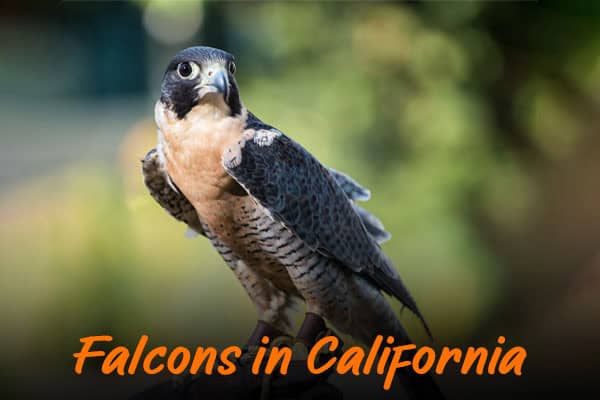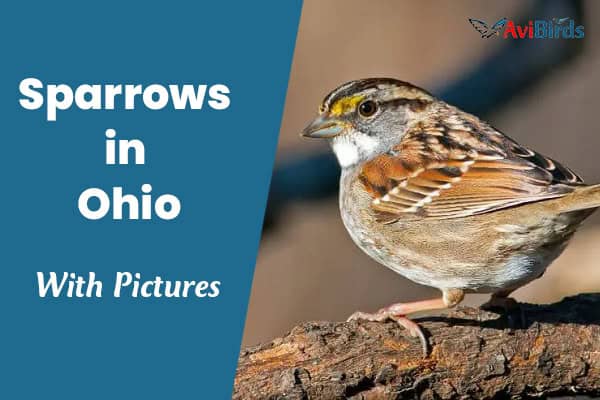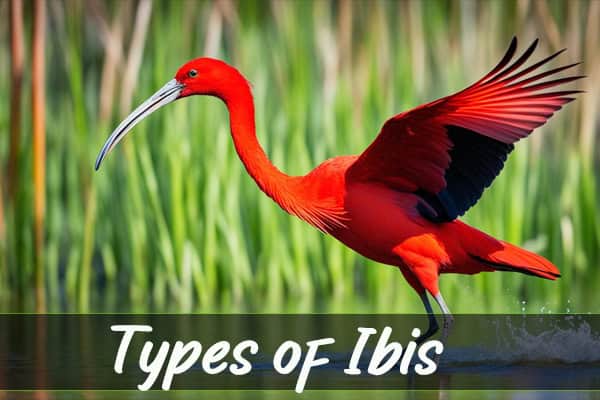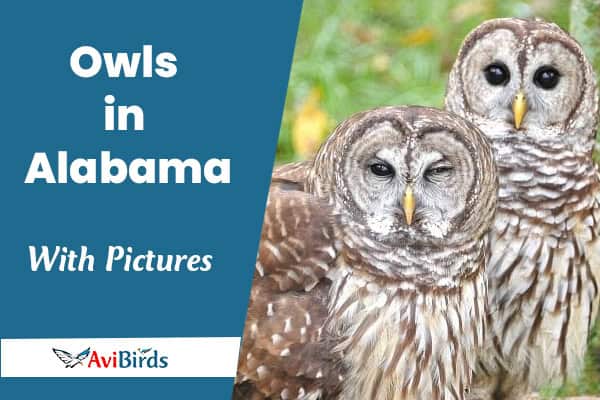4 Types Of Falcons In California (With Pictures)
Are you a bird enthusiast who loves the grace and speed of falcons? California is a great place for you. Falcons In California have a variety of these amazing birds. You can see everything from the fast Peregrine Falcon to the small American Kestrel.
California has the most birds in the United States. It’s a paradise for those who love nature. But what makes these falcons special, and where can you see them? Let’s find out about California’s amazing bird predators.
1. Peregrine Falcon
The Peregrine Falcon (Falco peregrinus) is a stunning bird known for its amazing speed and hunting skills. It has a slate-blue back, barred underparts, and a black “mustache” on its white face. This makes it a beautiful sight to see.

Identification and Appearance
Peregrine Falcons stand out with their strong build and long, pointed wings. They dive at speeds over 200 mph, making them the fastest birds on Earth when they hunt.
Nesting Habits
These falcons like to nest on cliff ledges, tall buildings, or in old nests of other birds. In California’s Mount Diablo area, they nest from February to July. During this time, some areas are closed to protect the birds. The baby birds hatch all at once, usually within 48 hours of each other.
Diet and Hunting
Peregrine Falcons eat mostly birds, from tiny hummingbirds to big cranes. They are very fast and agile in the air, catching their prey while it’s flying.
Conservation Status
In the mid-20th century, Peregrine Falcons had many fewer birds because of pesticides like DDT. But now, their numbers are back up. They were taken off the endangered list in 1999 and are now considered of Least Concern.
Where to Find Peregrine Falcons in California
You can see Peregrine Falcons all over California. They like coastal areas, mountains, and cities. In the San Francisco Bay Area, they nest on Alcatraz Island and in some parts of Mount Diablo State Park.
2. American Kestrel
The American Kestrel (Falco sparverius) is a bird of prey found in California. It’s the smallest falcon in North America. These birds are known for their unique look and hunting skills. Let’s explore the fascinating world of the American Kestrel.
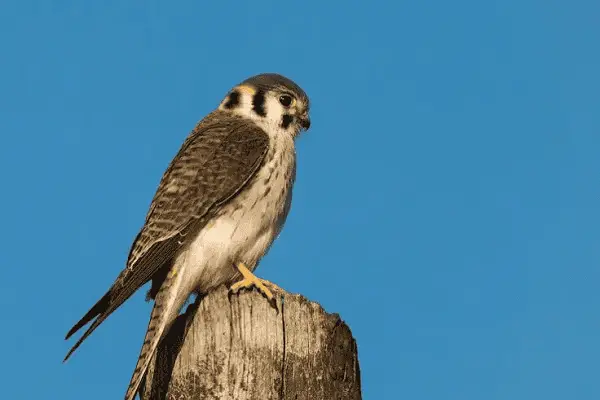
Identification and Appearance
The American Kestrel is easy to spot because of its striking look. Males have blue wings and a reddish underside. Females have a reddish-brown look. Both have black marks on their faces that look like a mustache and sideburns.
They are smaller than a Mourning Dove. This makes them the smallest falcons in the U.S. and Canada.
Nesting Habits
American Kestrels nest in many places like trees, rocks, and buildings. They lay three to seven eggs. Both parents take turns incubating the eggs.
This shows how adaptable they are in different environments.
Diet and Hunting
American Kestrels eat small animals like insects and birds. They often sit on wires or fences, watching for prey. They can hover in the air to catch their food with great precision.
Conservation Status
American Kestrels have fewer numbers now due to habitat loss. But they are still considered of Least Concern. Protecting their homes is key to keeping these falcons around.
“The American Kestrel is a true icon of the California skies, showcasing the incredible diversity and adaptability of our native avian species.”
3. Prairie Falcon
The Prairie Falcon (Falco mexicanus) soars over western North America’s wide-open lands. They are medium-sized, bigger than a Merlin but smaller than a Swainson’s Hawk. Their brown upper side, pale underside with brown marks, and dark underwing linings make them stand out when flying.
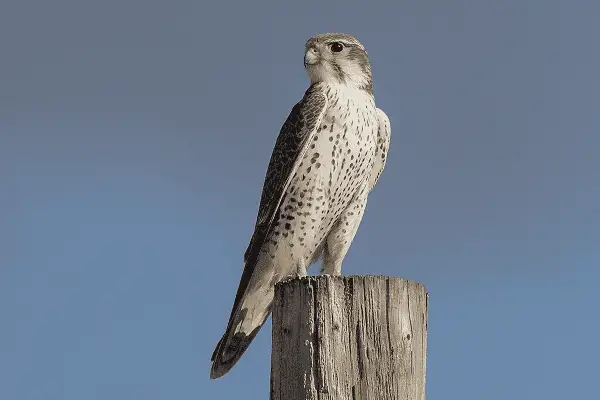
Identification and Appearance
Prairie Falcons are easy to spot with their unique color. They have a brown back, pale breast and belly with brown streaks, and a dark “mustache” stripe. Their pale stripe above the eye and lighter tail make them look striking.
Nesting Habits
These falcons nest high on rocky outcrops and cliffs in the western U.S. deserts. They come back to the same spots every year. They pick places that are safe from predators and have little vegetation around.
Diet and Hunting
Prairie Falcons are great hunters. They go after small mammals like ground squirrels and kangaroo rats, birds, and insects. They fly low and use the ground to surprise their prey.
Conservation Status
The global Prairie Falcon population is stable, with about 80,000 breeding pairs. But, they face threats from habitat loss due to cities and farms. The Mojave Desert Land Trust’s Prairie Falcon Conservation Program works to protect them. They keep a database of nests and work with local groups to help these birds.
Learning about the Prairie Falcon’s unique traits and conservation needs helps us protect these amazing birds. They are a key part of the American West’s beauty.
4. Merlin
The Merlin (Falco columbarius) is a small falcon that grabs the attention of birdwatchers and nature lovers. It has a unique look with a blueish-gray to black back, wings, and head. The underside is buffy to brown with streaks, and it has a white eyebrow stripe.

Identification and Appearance
There are three main types of Merlins in North America. The “black” Merlins are found in the Pacific Northwest and have a dark plumage. The “prairie” Merlins live in the northern prairies and have pale feathers. The “boreal” or “taiga” Merlins are in the northern forests and have feathers in between.
Adult male Merlins also show different looks based on their location. The “taiga” Merlin is medium gray with a pale mustache and a thin white eyebrow. The “prairie” Merlin is pale gray with a thin white eyebrow. The “black” Merlin is almost black with a thick mustache.
Range and Migration
Merlins live in many places, but they move north for the summer. They spend the winter in northern South America, Central America, Mexico, and parts of the U.S. The taiga subspecies is often seen in southern Oregon and northern California.
Diet and Hunting
Merlins eat small birds, insects, and rodents. They are bold hunters, using different tactics to catch their food. They scan from a perch, make quick flights, and chase birds in the air.
“Merlins employ various hunting strategies, including scanning for prey from a perch, launching short fast flights to catch prey mid-air, and engaging in short stoops or ‘tail-chasing’ to catch prey.”
Merlins are great hunters, even working together with their mates to catch prey. Their speed and skill in the air are amazing to see.
California’s Falcon Hotspots
California is home to many places where you can see falcons. From the beautiful coasts to the tough mountains, these birds can be found in various spots. These places are great for birdwatchers.
Top Birding Spots for Falcons in California
Some top spots to see falcons in California are:
- Point Reyes National Seashore
- Klamath Basin National Wildlife Refuges Complex
- Arcata Marsh and Wildlife Sanctuary
- Elkhorn Slough National Estuarine Research Reserve
- Golden Gate National Recreation Area
- Yosemite National Park
- San Gabriel Mountains
- Bolsa Chica Ecological Reserve
- Cabrillo National Monument
- Andrew Molera State Park
- Morro Bay
These spots offer a mix of habitats like coastal wetlands and mountains. They draw different falcon species to California.
“Morro Bay is described as a Globally Important Bird Area by the National Audubon Society, and it’s easy to see why. This stunning coastal region is a haven for peregrine falcons, shorebirds, and a wide variety of other avian species.”
Morro Bay is special because it’s home to many western snowy plovers. It’s also a place where thousands of shorebirds come to spend the winter. You can see peregrine falcons and many waterfowl and ducks near Morro Rock.
If you love birdwatching or just enjoy watching these amazing birds, California has great spots. You can see falcons in their natural setting.
The Importance of Falcon Conservation
Falcons are true icons of the avian world, known for their incredible speed and hunting prowess. These majestic birds of prey play a vital role in the ecosystems they inhabit. They help control small animal populations and contribute to the overall biodiversity of the region.
However, some falcon species have faced significant declines in the past. Factors like pesticide poisoning, habitat destruction, and illegal hunting have threatened their numbers.
Now, the global populations of many falcon species, including the Peregrine Falcon and American Kestrel, have rebounded. Yet, ongoing falcon conservation efforts are crucial for their long-term survival. Protecting their habitats, reducing harmful chemicals, and educating the public about the importance of falcons are key actions.
The American peregrine falcon is one of the fastest animals on the planet, reaching speeds over 200 mph when diving for prey. This species was once on the brink of extinction due to DDT. But thanks to conservation efforts, its population has made a remarkable recovery.
“Peregrine Falcons were once on the US Endangered Species List. Today, their populations have significantly bounced back through conservation efforts, though populations in the eastern US have never fully recovered.”
To protect falcon populations, ongoing monitoring and research are crucial. The U.S. Fish & Wildlife Service conducts regular population surveys. This helps track trends and potential reclassification under the Endangered Species Act. The U.S. Forest Service also designates the peregrine falcon as a “Sensitive Species.” This provides added protection against threats like illegal activities and habitat destruction.
By working together to address the threats to falcon populations and support their recovery, we can ensure that these magnificent birds continue to soar high in the skies for generations to come.
Check Our Previous Articles:
Wrapping Up…
California is home to many falcon species, like the Peregrine Falcon, American Kestrel, Prairie Falcon, and Merlin. These birds are known for their speed and hunting skills. They are a joy for those who love birds and nature.
Learning about these falcons helps us see their importance in California’s nature. It also encourages us to protect them for the future.
The Santa Cruz Predatory Bird Research Group has helped the Peregrine Falcon recover from near-extinction. Now, there are about 250 pairs in California. Webcams let people worldwide watch these falcons, making us care more about nature.
When visiting their habitats, remember the dangers they face, like DDT, human disturbance, and losing their homes. Supporting conservation and watching wildlife responsibly helps these falcons stay safe in California.

